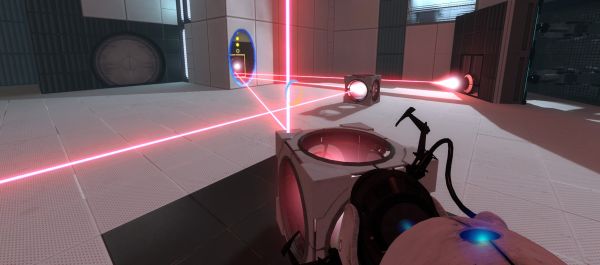The Portal 2 That Could Have Been
Alternative histories.
Imagine a Portal 2 with no GLaDOS, Chell, nor portals. Set in the 1980s. With competitive multiplayer and quantum co-op. And multiple endings. At various points, those were all things that could have hapened, as revealed by Valve last night in San Francisco.
Why make a sequel to Portal is a good question. The short game wrapped up perfectly, was wrapped up in its own legend, and things felt done. But, revealed two of Valve's lead writers, Chet Faliszek and Erik Wolpaw, there were 150 people at Valve who hadn't worked on a Portal game and wanted to. There was just a desire amongst their staff to have a go with the series, and so it was that work began.
Things started with a small team of 15, far short of the 70 that were on the project by the time it shipped, bashing ideas around and trying to work out what should be done next in this universe. And the ideas they reached were... peculiar.

Valve have talked a few times in the past about how Portal 2 almost didn't feature portals at all. The game was also due not to feature Chell, nor GlaDOS. Which to hear sounds just completely insane. That's partly because it is. But it's interesting to realise how Valve reached that place.
They, Chet Faliszek pointed out, had lived with GlaDOS for years. While the player had spent a couple of hours in her company, the developers had heard her autotuned tones incessently for a huge portion of their lives. Forgetting to look outside of their own bubble, they'd transfered their own weariness onto the players, who of course wanted nothing more of the character that had so entertained them for such a short amount of time.
Chell was more complex. While playtesters instantly baulked at the absence of the evil robot, none cared at all that they werent Chell. One early build of the game had you wake up in front of a mirror, revealing a long-haired girl in a different coloured jumpsuit, clearly not the previous protagonist. Known internally as Mel, players were happy to be her... until a certain point. The moment they met GlaDOS. As the malevolent machine awakes and doesnt recognise the player, suddenly they were thrown out of the experience. And Chell was put back in.
As for the portals - the mysterious F-Stop system that replaced them, something Valve still aren't talking about in case they use it elsewhere, was apparently great. Players said, "Yes, this is awesome. But it's not Portal. Why are you calling it Portal?" And they realised that was probably a good point.

Even so, they built some prototype code of their reimagined game, which was shown to the crowd at yesterday's event. Waking up on a beach, you see an idyllic situation, rolling seas, blue skies, and golden sand. Take a step and a framed glass screen flings up from the sand to block your path. Turn and the same happens, screens flying up all over, trapping you into a cage. Then the sea starts to drain away, revealing an empty concrete bowl around you, as the sky switches off, the palm trees start collapsing into the ground, and the stark reality of your imprisonment is revealed. It was pretty awesome. Perhaps not quite as awesome as the final game's extraordinary scenerey-crashing sequence, but funny and impressive none the less.
This incarnation was also due to feature a cameo from GLaDOS. With Cave Johnson intended to be the main protagonist, in a game set in the 1980s, pre-Aperture's destruction, a less evil GLaDOS was going to briefly feature adding "small print" to statements from Johnson, in the manner of US drug commercials where all side effects are read out. As Wolpaw put it, "like when they show you puppies while talking about rectal bleeding."
Three months was spent working on this version of the game, before the feedback convinced them they had gone in completely the wrong direction. But it wasn't the only dead end they found themselves walking down.
An early version of Wheatley was to only exist for the first portion of the game, to be killed the moment GLaDOS appeared, demonstrating her evil. And he wasn't coming back. But what he was doing was falling down some stairs. This became an example of a developer falling in love with an idea and then almost destroying themselves trying to make it happen. It was important, they said, that the player could drop Wheatley, because it didn't make sense to force them to carry him. But to make sure he wasn't left behind they'd have to "gate" the player, ensuring Wheatley came with them by making the doors only open with his help. And as a bonus, they'd recorded dialogue for the player being able to drop Wheatley down these stairs, and they loved it.
As the sequences went through major changes, each new build still featured stairs just so they could keep the gag. And in fact, when you play the game, in which you'll notice you can't drop Wheatley, those stairs still exist. And why can't you drop him? Because yet again they realised that no one other than them actually cared. If players didn't know dropping him was an option, nor that doing so would offer a fun joke, they didn't care at all. However, something that people probably would miss if only they'd known they could have it was Wheatley's original way of appearing. In an early version, the not-so-bright orb had set up a series of intricate turret-based defenses, all focused on one door in front of him, meaning the player needed only portal in behind him to pick him up. And at this point, the dimbo was being voiced by one of Valve's own team, temporarily before Stephen Merchant's dialogue was recorded - something that Valve still receive requests to put back into the game for players to hear. They promised they never would.

But if I were to fight for the re-addition of a cut character, with would be the sphere known internally as the Morgan Freeman Sphere. At one point there were to be a whole series of different spheres with different personalities, punctuating chapters of the game, and one would be Morgan, an orb who had been left in a 20x20 inch area for decades, gradually growing wiser and wiser... about that 20x20 space. Speaking with the wise tones of the actor, he would impart his knowledge and wisdom to you, with deadpan sincerity, all focused on what he'd learned, only to be completely terrified by the rest of the laboratories around him. I want him.
A particular point of struggle was the game's ending. They knew from the first game that it was important that the final challenge not be the most difficult of the game, but rather focus on story. But early versions were terrible, and it was getting dangerously late in production when they still had no idea how to end it. Flopsweat soaked meetings, Wolpaw explained, had the writing team failing to get anywhere with a finish that was good enough. One versio saw an incredibly anticlimactic finale, fighting the corrupted Wheatley, in which turning the machine off involved uttering the word "Yes". Chell was to speak! Just one word, but a word that would end everything. "And it sucked," said Wolpaw. But then, strangely enough, it was some goof endings that saved them.
Playtesting the first game had revealed that there were some players willing to die in the game's false ending. As they descended toward the fire pit they accepted their fate, and were perfectly happy to let the game end there, before the final thrd's dramatic escape seqence. Which inspired the team to put in opportunities like this into the sequel. A number of points where the game could just end if the player let it, even only minutes in. There would be a song for each, appropriate to the nature of the death, and frankly that sounds brilliant. And one of these planned endings was to have you be abandoned on the moon.
A scene was going to have a crack in the ceiling, through which the moon was visible. A player adventurous enough to try firing a portal that way woul find themselves transported into the vacuum and asphixiate, after which a song about how sad it was to die on the moon would play. And it was this that they finally realised was a big enough, and funny enough idea to put on the end.
The other element to see some major change was the co-op. Hilariously, Valve figured this would be a breeze to do, and left it quite late in the production to really focus on. And then realised it was a far bigger challenge. Originally GLaDOS was to have the two robots battling it out in an eternal series of tests, to sate her urges. But she was to realise that with no human observers, the results of all these tests were left in a quantum state. To combat this, she sent the robots off on missions to recover human artefacts, in an attempt to make them more human.
At one point they would return with a newspaper panel cartoon featuring a lazy cat and his owner, featuring a joke about lasagne. Drawn by Nedroid, it was a particularly cruel dig at Jim Davies' Garfield, which none of the robots understood, leading GLaDOS to re-write it and add in some humour. Which is to say, to have all the characters be needlessly killed.

Also abandoned, but not until three months had been spent on it, was a competitive multiplayer mode. Wolpaw described it as, "a cross between Speedball 2 and Portal, except with none of the good parts of either." It too was abandoned so the team could focus more on the co-op.
A strange phenomenon, the two writers revealed, is that whenever they talk about older versions of their games, a vocal group of players will demand access to them, certain they would have been better than whatever was released. But, explained Faliszek, oddly enough they tend to put the best versions of everything into the games they release. None of those older versions will ever be played, meaning the glimpses shown are the closest they're ever going to let us get to them.









